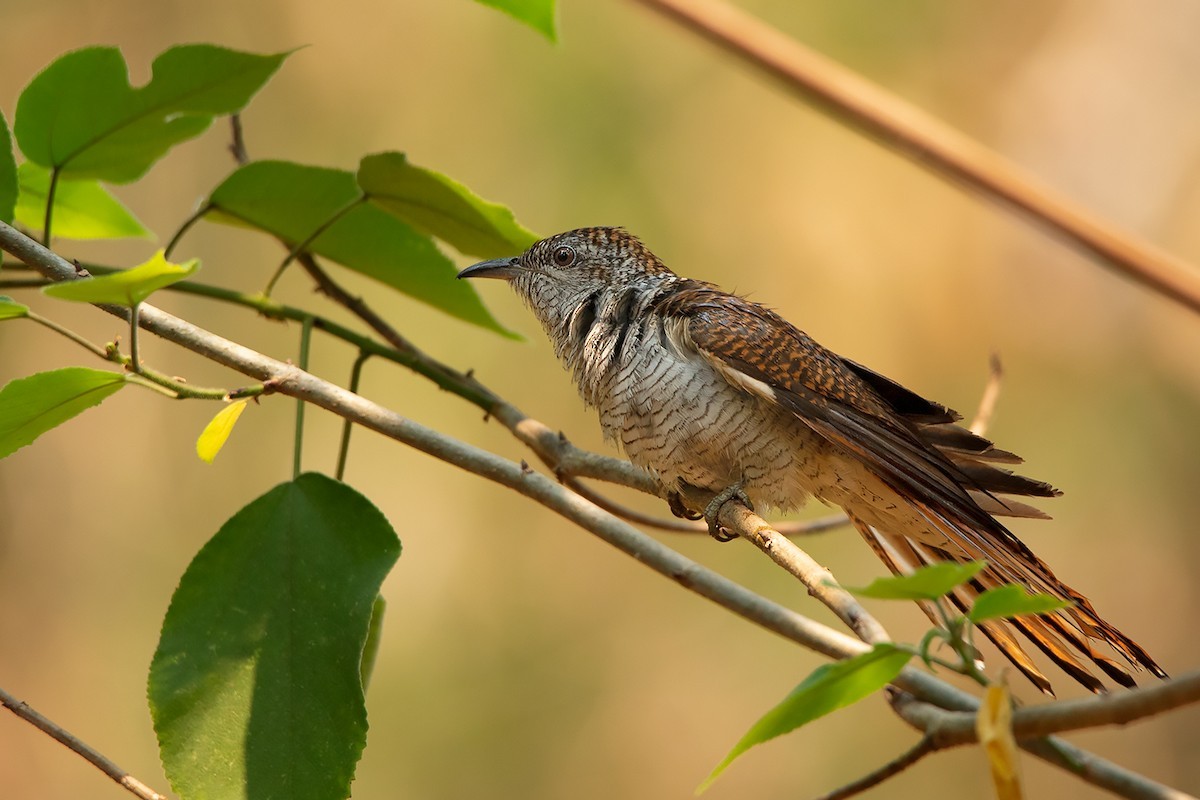Banded Bay Cuckoo
A species of Oriental and Australasian Cuckoos Scientific name : Cacomantis sonneratii Genus : Oriental and Australasian Cuckoos
Banded Bay Cuckoo, A species of Oriental and Australasian Cuckoos
Botanical name: Cacomantis sonneratii
Genus: Oriental and Australasian Cuckoos
Content
Description General Info
 Photo By Ayuwat Jearwattanakanok
Photo By Ayuwat Jearwattanakanok Description
The adults are bright rufous or bay on the head and back and are broadly barred with dark brown. The bill is long and slightly curved. A whitish supercilium is distinctive above a dark eye-line. The wing is darker and tail is graduated with a dark brown centre. The tail has a subterminal black band and white tips to the feathers. The sexes are alike. The iris is yellow and the bill is black while the base of the lower mandible is greenish grey. The tarsi are grey. The juvenile is similar but has a pale lower mandible and white fringes to the feathers of the upper body. The overall length is about 22 cm making it about the same size as the syntopic Cacomantis merulinus and Cacomantis variolosus. The hepatic forms of those can be similar but supercilium, long beak and barred tail distinguish this species. 
Size
22 cm
Nest Placement
Tree
Feeding Habits
Banded Bay Cuckoo primarily feeds on insects, with a preference for caterpillars from the Pieridae, Notodontidae, and Arctiidae families. It also consumes bugs and grasshoppers, employing diverse foraging techniques to capture prey.
Habitat
The habitat of banded Bay Cuckoo typically includes a variety of wooded environments such as both open and dense broadleaf forests, incorporating regions of deciduous and evergreen flora. These birds are also found at forest edges, secondary scrub areas, and occasionally within cultivated lands. They predominantly inhabit lower elevation lands.
Dite type
Insectivorous
General Info
Feeding Habits
Bird food type
Behavior
Like many other cuckoos, they are brood-parasitic and hosts recorded include the common iora, red-whiskered bulbul, white-bellied erpornis, scarlet minivet, bulbuls and small babblers (Stachyris spp.). The eggs resemble those of the hosts. The incubation and nesting are not well documented. Fledglings of the host are evicted. Populations are often migratory or partially migratory. In India, they are found mainly during the monsoons. They are found in well-wooded forests, mainly in hill areas. Insects are their primary diet. They capture insects by gleaning as well as by aerial sallying. The breeding season varies widely from region to region. Near Bombay they are known to lay eggs from February to August, Assam from April to August while they seem to sing through much of the year in the Eastern Ghats. In Sri Lanka, young have been seen in June and October while adults sing from January to May in the Malay Peninsula. The call of this species is distinctive. It is high-pitched four note whistle that has been transcribed as "wee-ti wee-tee" or "smoke-yer-pepper". The frequency starts at 2.4 kHz and each note falls in pitch with the strophe lasting a second. 

 Photo By Ayuwat Jearwattanakanok
Photo By Ayuwat Jearwattanakanok